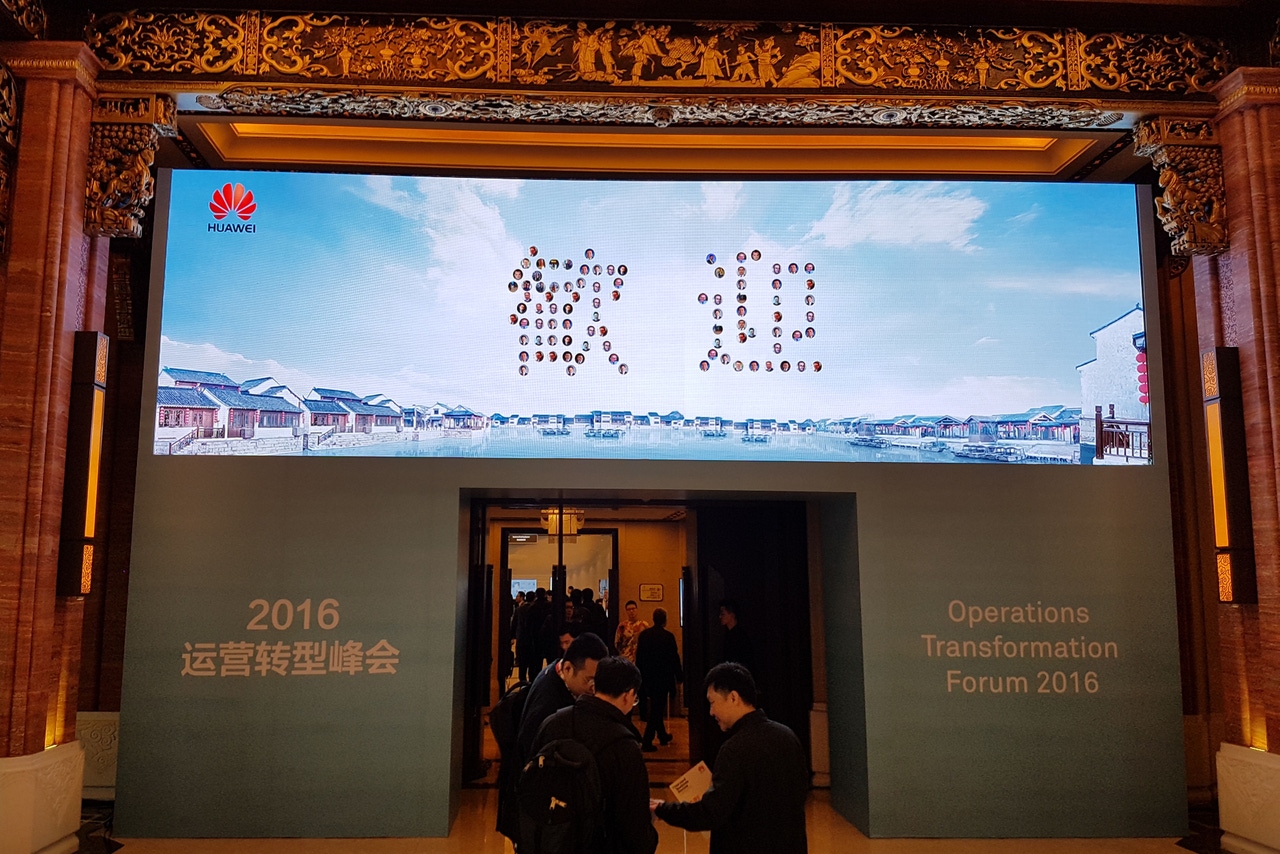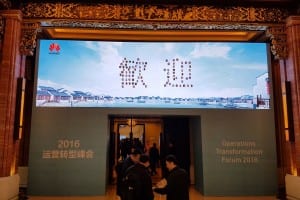Huawei urges operators to embrace the video opportunityHuawei urges operators to embrace the video opportunity
Global ICT giant Huawei feels so strongly about helping operators diversify that it devoted an entire two-day event in the beautiful historic town of Wuzhen to exploring the issue.
December 2, 2016

Global ICT giant Huawei feels so strongly about helping operators diversify that it devoted an entire two-day event in the beautiful historic town of Wuzhen to exploring the issue.
The event in the first week of November was named the Operations Transformation Forum (OTF) and, as the name implies, it focused not just on new business opportunities for operators but the ways in which they need to transform themselves if they want to capitalise on them.
 Digital transformation is a popular buzzword in business right now, along with its close relative DevOps. Both are rather vaguely defined but essentially point towards a new way of operating, especially for large companies, that puts an emphasis on agility, flexibility and customer centricity. For this to happen many companies need to significantly change the way they work.
Digital transformation is a popular buzzword in business right now, along with its close relative DevOps. Both are rather vaguely defined but essentially point towards a new way of operating, especially for large companies, that puts an emphasis on agility, flexibility and customer centricity. For this to happen many companies need to significantly change the way they work.
On a day-to-day basis there is little need for engineers to talk to marketers, or customer care agents to interact with BSS developers. And yet if operators truly want to be customer facing – i.e. putting the needs of customers ahead of their own internal processes – then all these self-contained business units need to be joined up.
The term ‘customer-centric’ is itself a buzzword that immediately predates all this talk of transformation. At first glance it seems somewhat redundant; why would companies be anything else? If you’re not customer-centric then what are you – customer-phobic? What it really meant was that every part of the company needs to be geared towards serving its customers, not just marketing, customer support, etc.
That requires a major cultural shift in many companies, hence the need for the kind of operational transformation Huawei dedicated this event to. The culture of any company starts at the top and trickles down so the CEO and senior management must be the champions of any cultural change. Furthermore, the whole structure of the company needs to change to reflect this customer-centric approach and to ensure it is as easy as possible for everyone in the organization to contribute to it.
Wuzhen was, in many ways, a perfect setting for an extended discussion about technology and culture. The town has been preserved and restored so effectively that it’s easy to feel transported back a thousand years to the time of the Song dynasty. The world has clearly transformed many times since then and yet in Wuzhen we are reminded how vibrant culture was before we had even electricity, let along smartphones and Netflix. And as an illustration of how diverse culture can be there can be few more different places than central London and Wuzhen.
One of the Huawei executives driving OTF 2016 was Alex Ping-an Zhang, who is President of the Carrier Software Business Unit and a member of the Huawei board. In his keynote speech at the event Zhang identified three main approaches to digital operational transformation: add-on, which is a piecemeal upgrade of one system or process at a time; stand-alone, which involves the development of a whole new system in parallel with the legacy ones; and big-bang transformation, which is a full commitment and the most radical course.
 “In terms of the three transformation approaches we find that some carriers are fearful of radical transformation and consistently re-adapting,” said Zhang. “They chose to conduct gradual transformation through the add-on or stand-alone approach, which involves changing or developing limited number of operations systems and components. We also find that these transformation approaches prolong the overall transformation time, preventing carriers from meeting user experience requirements and seizing market opportunities for diverse digital services.
“In terms of the three transformation approaches we find that some carriers are fearful of radical transformation and consistently re-adapting,” said Zhang. “They chose to conduct gradual transformation through the add-on or stand-alone approach, which involves changing or developing limited number of operations systems and components. We also find that these transformation approaches prolong the overall transformation time, preventing carriers from meeting user experience requirements and seizing market opportunities for diverse digital services.
“If your vision is to get a Ferrari you cannot just replace the suspension, engines or tires on your current car. At the same time if your vision is to build a hundred-story skyscraper, start with a strong foundation and architecture. You cannot just replace the current beams of your current building.”
Of all the opportunities available to operators if they are able to adapt and evolve is something Huawei calls ‘Big Video’, which essentially refers to the provision of video over telecoms networks (as opposed to broadcast) on a much greater scale than is currently possible. Zhang is a passionate advocate of this opportunity and feels now is the time for them to act. Telecoms.com spoke to him after his keynote and asked him why he feels so strongly about the operator video opportunity.
“I think the video opportunity for operators is tremendous because we are at a time when their infrastructure can support at least 50 Mbps to the home,” said Zhang. “That gives them a very good foundation and allows them to penetrate the video service market, which needs high bandwidth infrastructure. We think that video will account for over 70 percent of the traffic through the pipe as demand for content and other video services continues to grow.
Whether they like it for not telcos have essentially become data pipes. Their perennial fear is of becoming commoditized or in the industry parlance ‘dumb pipes’. They are constantly looking for ways to add value to those pipes and Zhang thinks this is where the video opportunity lies. As the owners of the pipes, operators are in the strongest position to control what flows through them.
If video is going to become the fundamental service for operators they cannot treat it as a separate service,” said Zhang. “They need to consider video to be one of their core offerings together with fixed access, mobile access and mobile data. That will allow them to expand their video subscribers rapidly and provide it as a complementary service.
“That in turn creates numerous opportunities for value added video services. Many enterprises want to provide video services to their customers, such as call centres, which want to have video interactions with their customers but don’t currently have a solution. Another example is banks, which want to enable video interactions for moving money using face and voice recognition. Here at Huawei we have a lot of meetings and events and we want to use live video to reduce the need to travel.”
 Operators are good at offering a metered pipe – i.e. charging per minute or megabyte – but not so good at value-added services. But at needs to change in the era of on-demand video because people don’t want to think about data limits, they just expect to access content when and where they want it. And they certainly don’t want to be constantly worrying about their data allowances while they do it. To be truly customer-centric operators need to enable this and that will require substantial change.
Operators are good at offering a metered pipe – i.e. charging per minute or megabyte – but not so good at value-added services. But at needs to change in the era of on-demand video because people don’t want to think about data limits, they just expect to access content when and where they want it. And they certainly don’t want to be constantly worrying about their data allowances while they do it. To be truly customer-centric operators need to enable this and that will require substantial change.
While operators have the infrastructure advantage they still need to improve it, especially to provide consistent high quality service across all regions,” said Zhang. “They also need to get the right operations team in place because video services need end-to-end high quality care and people have zero tolerance for poor quality.
“A lot of operators have different functionalities and different people to take care of different parts like the network, operations and maintenance, service provision and quality control. But if they want to have video as a fundamental service across their whole subscriber base they need to have end-to-end organisation and a different operations model. They also need to consider creating an open video ecosystem for developers, to help them provide all kinds of video service to their end users, including user-generated content.”
As you would expect Huawei thinks it’s the company to enable operators seize the video opportunity. A consistent theme from many Huawei execs at the event was that the company can’t expect to operators through the process of operational transformation unless it has implemented it first. It’s impossible to know, from the outside, how this process is going at Huawei, but the company does seem to be committed to it.
On the commercial side Zhang was keen to bring attention to the Huawei’s cloud-based hybrid video platform, which aims to provide operators with the infrastructure they need to serve up Big Video.
“We think our hybrid video platform and video terminals can help operators become one-stop solution providers,” said Zhang. “Our hybrid platform does fixed/mobile and all kinds of other video convergence to provide a unified platform for any kind of service. We have opened our API to operators, to allow their developers build the ecosystem and we also provide consulting services to share best practice and operations assistance to help them transform and build the right operations model.
“We consider all cameras to be video access terminals and we can receive and hold that video in our platform, and let people do what they want with it. We hope that in future all cameras will be linked to a cloud video platform, but bandwidth will remain the key.”
 We’re used to thinking about video in the cloud, but primarily thanks to OTT services such as YouTube or Netflix rather than operators. It seems likely that networks will always be relatively dumb-pipes for that kind of content but what about the many other types of user generated video such as smartphones, surveillance cameras, etc? For end users a constant connection to the cloud, facilitated by operators, would mean they never have to worry about local storage and could, in theory, record video indefinitely.
We’re used to thinking about video in the cloud, but primarily thanks to OTT services such as YouTube or Netflix rather than operators. It seems likely that networks will always be relatively dumb-pipes for that kind of content but what about the many other types of user generated video such as smartphones, surveillance cameras, etc? For end users a constant connection to the cloud, facilitated by operators, would mean they never have to worry about local storage and could, in theory, record video indefinitely.
“Their infrastructure asset is their advantage,” said Zhang. “People will increasingly demand services like 4K video and virtual reality and will always want more, such as 8K. Operators are well positioned for that kind of business and will be far ahead of OTT players in that environment. OTTs cannot control the infrastructure part – they can build services on the current infrastructure but they can’t afford to try to keep pace with operators on infrastructure improvements.
An extension of the ‘dumb pipe’ cliché in the telecoms business is that OTT players are eating the operators’ lunch. The very term – Over The Top – is intrinsically telecoms-centric as it paints internet companies as opportunistic exploiters of the network, when all they’re doing is offering services and letting the end user work out how to access them. A more positive way of looking at them is as drivers of demand for the operators’ main product.
“Many people think OTTs put a lot of competitive pressure on operators but I don’t think that is right because OTTs also help to consume bandwidth, which is the basic service operators offer. So they are actually complementary,” said Zhang.
That final point brings us back to the broader theme of operational transformation and how that is as much a cultural as a technological or commercial process. Operators’ first instinct was to view OTTs as a threat and try to beat them at their own game – usually with disastrous results. The smart move is to play to your strength while adapting to the evolving market environment. Mobile video is here to stay and operators can make a lot of money from it, but only if they ensure their entire organisation is in a position to exploit emerging opportunities as soon as they present themselves.
Read more about:
DiscussionAbout the Author
You May Also Like










.png?width=300&auto=webp&quality=80&disable=upscale)


_1.jpg?width=300&auto=webp&quality=80&disable=upscale)